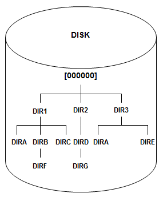
OpenVMS uses the command language DCL which is not case sensitive. The commands can also be abbreviated (ex. “show default” can be “sh def”).
Dollar Universe commands on OpenVMS must respect the standard syntax of the system to enter the parameters.
The VMS environment is composed of disks (physical or virtual), directories and subdirectories.
To access files and directories through the command line, the user can enter an absolute path or relative path.
set default DISK$USER:[directory.subdirectory]
set default [.directory.subdirectory]
Each disk has a master directory [000000]. The diagram below demonstrates how directories and sub-directories are connected to the master directory.

Figure 5: OpenVMS Directory Structure
Administration
Verify the privileges for the current user:
show process/privilege
Grant a specific privilege to the current user:
set process/privilege=(privilege_name)
Grant all privileges to the current user:
set process/privilege=all
Files and Directories
Files can have the following rights: Read, Write, Execute and Delete.
The uninstallation procedure needs to be able to delete files.
To add the license to the u_fal01i.txt file, the file must have the read, write and edit rights.
Adding rights to a file (owner rights in this example):
set security/protection=(O:RWED)filename.txt
List the files in the current directory:
directory
List the files in a specific directory:
directory disk:[directory.sub-directory]
Show the contents of the current directory:
show default
Move up a directory:
set default [-]
Move down a directory:
set default [.sub-directory]
To copy a file into a sub-directory:
copy <file_name> [.sub-directory]
To launch a command in a specific sub-directory of the current directory:
@[.directory]unistart
Delete a directory:
delete directory_name.dir;*
Delete contents of a directory:
delete/tree [.directory...]*.*;*